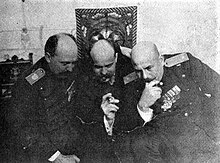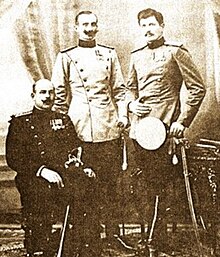Dragutin Dimitrijević
Dragutin Dimitrijević | |
|---|---|
 Dimitrijević, c. 1900 | |
| Born | 17 August 1876 |
| Died | 26 June 1917 (aged 40) |
| Cause of death | Execution by firing squad |
| Nationality | Serbian |
| Other names | Apis |
| Signature | |
Dragutin Dimitrijević (Serbian Cyrillic: Драгутин Димитријевић; 17 August 1876 – 24 June 1917), better known by his nickname Apis (Апис), was a Serbian army officer and chief of the military intelligence section of the Royal Serbian Army general staff in 1913. He is best known as the main leader of the Black Hand, a paramilitary secret society devoted to South Slav irredentism that organised the 1903 overthrow of the Serbian government and assassination of King Alexander I of Serbia and Queen Draga.[1] Many scholars believe that he also sanctioned and helped organize the conspiracy behind the assassination of Archduke Franz Ferdinand on 28 June 1914. This led directly to the July Crisis and the outbreak of World War I.
In 1916, the government in exile of Serbian Prime Minister Nikola Pašić, who considered Dimitrijević's refusal to compromise on South Slav irredentism to represent a serious threat to the secret peace negotiations taking place with Vienna during the Sixtus Affair, filed charges of high treason against the leadership of Unification or Death. Dimitrijević was tried in Thessaloniki before a Serbian Army court martial arraigned by his opponents within the Serbian government. He was found guilty of conspiring to assassinate both the Archduke and Prince Regent Alexander Karađorđević and executed by firing squad, along with two senior associates on 26 June 1917.
Early life
Dragutin Dimitrijević was born in Belgrade, Principality of Serbia, on 19 August 1876 to an Aromanian family.[2] His father and two brothers were often away working as tinsmiths and he grew up with his two older sisters in Niš.[2] At the age of nine, his father died.[2] After Dimitrijević's oldest sister married, the family moved back to Belgrade where, at the age of 16, Dimitrijević attended the Lyceum of the Principality of Serbia followed the Belgrade Military Academy as a cadet in 1892.[2] Dimitrijević finished the academy's lower school as sixth in his class in 1896. Two years later, he enrolled in the higher school. A brilliant student, upon graduation, he was assigned to the General staff of the Serbian Army,[2][3] an indication that his superiors held him in high regard.[4]
May Coup

In 1901, Dimitrijević participated in the organisation of the first failed attempt to murder the unpopular and pro-detente with Austria-Hungary King Alexander. On 11 June 1903 the plotters succeeded when Dimitrijević and a group of junior officers stormed the royal palace and killed King Alexander, his wife, Queen Draga and three others. During the attack, Dimitrijević was shot three times, and the bullets were never removed from his body.[3]
Following the regicide, the Serbian Parliament described Dimitrijević as "the saviour of the fatherland". In his memoirs, former Imperial Russian Foreign Office official Dmitri Abrikosov traced the inception of the Russo-Serbian military alliance that helped cause the First World War to the immediate aftermath of the 1903 palace coup and regicide. The new anti-Habsburg government of Serbia, as had been desired by Dimitrijević, dispatched a very clever diplomat to St Petersburg, where he successfully "wooed the Slavophiles" within the last Tsar's government.[5]
After various commands and staff positions he taught tactics at the Belgrade Military Academy. Around 1906 Dimitrijević visited Russia and Germany, where he learned the language and studied the latest military programs. In 1911 he helped founding Ujedinjenje ili Smrt (Unification or Death), commonly known as the Black Hand, a conspiratorial network supporting the formation of a Greater Serbia state. Dimitrijević, who used the code name Apis, became the leader of the Black Hand.[6]
Dimitrijević's main objective was the liberation and unification of all Serb populated regions under Ottoman or Austro-Hungarian rule, this became more urgent after the monarchy annexed Bosnia and Herzegovina in 1908 provoking the Bosnian Crisis. Austrian officials regarded the aspirations of Pan-Serbs as a significant threat to the Hapsburg Empire. During the Balkan Wars in 1912 and 1913, Dimitrijević took no part in the fighting.[7] Dimitrijević had his men disguise as Albanians and commit political murders.[8][additional citation(s) needed] In 1913 Dimitrijević was appointed chief of general staff intelligence in the Serbian army.[7]
Assassination of Archduke Franz Ferdinand

In 1911, Dimitrijević had organised an attempt to assassinate the Austrian Emperor Franz Josef. In early 1914 after finding out that three young Bosnian Serb students, led by nineteen year old Gavrilo Princip, were plotting to assassinate the heir to the Austro-Hungarian Empire, during his upcoming visit to Sarajevo,[9] the Black Hand provided the conspirators with weapons and training in Belgrade. The support came from railways employee Milan Ciganović, a member of the Black Hand, with the presumed approval of Dimitrijević.[10]
According to historian Christopher Clark, it is possible that Ciganović had been informing Serbian Prime Minister Nikola Pašić about the plot, but this speculation rests on indirect evidence. It is however believed that, after being warned of the presence of Bosnian terrorists, Pašić gave instructions for the arrest of young Bosnians who attempted to cross back into Bosnia.[11] However, his orders were not implemented, and the three men arrived in what was then known as the Condominium of Bosnia and Herzegovina, where they joined forces with fellow conspirators recruited by Princip's former roommate Danilo Ilić,[12] Veljko and Vaso Čubrilović, Muhamed Mehmedbašić, Cvjetko Popović and Miško Jovanović. On 28 June 1914 Princip mortally wounded Franz Ferdinand and his wife Sophie, Duchess of Hohenberg.[13]
Surviving conspirator Vaso Čubrilović stated that the pistols and bombs used in the assassination were supplied to fellow Black Hand member Gavrilo Princip by Dimitrijević in Belgrade and then smuggled across the border, along with cyanide capsules for the conspirators to use to commit suicide in the event of capture. The failure of these cyanide capsules to work properly allowed the conspirators, who had received absolutely no training in how to withstand interrogation, to be easily tricked by Austrian police detectives and investigative magistrates into confessing and revealing the Colonel's involvement.[14]
On 23 July 1914, the Austro-Hungarian government sent its July Ultimatum to the Serbian government with a list of ten demands. In his response on 25 July 1914, Pašić accepted all the points of the ultimatum except the sixth, which demanded that Serbia allow an Austrian delegation to participate in a criminal investigation against those participants in the conspiracy that were in Serbia. Three days later, Austria-Hungary declared war on Serbia. In 1916, Dimitrijević was promoted to colonel[15] shortly before his arrest on charge of high treason.[7]
Execution
While engaged in secret peace negotiations with Emperor Charles I of Austria-Hungary during the Sixtus Affair that hinged upon showing that he was committed to preventing post-war outbreaks of state terrorism in the name of Yugoslavism or creating a Greater Serbia, Pašić decided that Col. Apis represented far too serious of a threat to Serbia's chances of regaining its independence.[16][17][18] The Prince Regent and the Prime Minister both set out to get rid of him and the most prominent leaders, even though the Black Hand had officially disbanded. Dimitrijević and several of his military colleagues were arrested in December 1916 and court-martialed for both the murder of the Archduke and the attempted assassination of Prince Regent Alexander I of Yugoslavia in September 1916. On 23 May 1917, during the Salonika Trial, Dimitrijević and three of his fellow defendants, Ljuba Vulović, Rade Malobabić, and Muhamed Mehmedbašić, confessed their roles in the assassination of the Archduke.[19] Col. Dimitrijević was accordingly found guilty of high treason and sentenced to death.[20]
In justifying the use of the death penalty, Prime Minister Pašić wrote to his envoy in London: "...Dimitrijević (Apis) besides everything else admitted he had ordered Franz Ferdinand to be killed. And now who could reprieve them?"[21]
A month later, on 24 June 1917, Dimitrijević was executed by Royal Serbian Army firing squad. His last words were, "Long live Yugoslavia!"[22]
In 1953, Dimitrijević and his codefendants were all posthumously retried by the Supreme Court of Serbia and found not guilty because there was no proof of their alleged participation in an assassination plot against the Prince Regent.[23]
References
Notes
- ^ MacKenzie 1989.
- ^ a b c d e MacKenzie 1997.
- ^ a b Duffy, Michael (22 August 2009). "First World War.com - Who's Who - Dragutin Dimitrijevic". www.firstworldwar.com. Retrieved 2019-11-28.
- ^ Clark 2012, p. 11.
- ^ Revelations of a Russian Diplomat: The Memoirs of Dmitrii I. Abrikossow, University of Washington Press, Seattle, 1964, p. 122-125.
- ^ Rubin & Rubin 2015, p. 23.
- ^ a b c Hall 2014, p. 93.
- ^ Pearson 2005, pp. 27-28 and 585.
- ^ Butcher 2015, p. 251.
- ^ Butcher 2015, p. 255.
- ^ Clark 2012.
- ^ Butcher 2015, p. 269.
- ^ Butcher 2015, p. 24.
- ^ Edited by Svetlana Palmer and Sarah Wallis (3002), Intimate Voices from the First World War, William Morrow. pp. 3-11.
- ^ "Dragutin Dimitrijević | Serbian army officer". Encyclopedia Britannica. Retrieved 2019-11-28.
- ^ MacKenzie 1995, p. 53.
- ^ MacKenzie 1995, pp. 70–71.
- ^ MacKenzie 1995, p. 72.
- ^ MacKenzie 1995, pp. 329, 344–347.
- ^ Rudić, Srđan; Biagini, Antonello, eds. (2015). Serbian-Italian Relations: History and Modern Times : Collection of Works. The Institute of History, Belgrade / Sapienza University of Rome, Research center CEMAS. p. 56.
- ^ MacKenzie 1995, p. 392.
- ^ Djordjevic, Dimitrije (1980). The Creation of Yugoslavia, 1914-1918. Clio Books. p. 47.
- ^ MacKenzie 1998, p. 290.
Bibliography
- Blakley, Patrick R. F. (2009). "Narodna Odbrana (The Black Hand): Terrorist Faction that Divided the World" (PDF). Oswego Historical Review. 2: 13–34.
- Butcher, T. (2015). The Trigger: Hunting the Assassin Who Brought the World to War. Vintage Books. Vintage Publishing. ISBN 978-0-09-958133-8.
- Clark, Christopher (2012). The Sleepwalkers, How Europe Went to War in 1914. London: Allen Lane. ISBN 9780061146657.
- Hall, R.C. (2014). War in the Balkans: An Encyclopedic History from the Fall of the Ottoman Empire to the Breakup of Yugoslavia. ABC-CLIO. ISBN 978-1-61069-031-7.
- MacKenzie, David (1989). Apis: The Congenial Conspirator. The Life of Colonel Dragutin T. Dimitrijevic. New York: Columbia University Press. ISBN 0-88033-162-3.
- MacKenzie, David (1995). The "Black Hand" on Trial: Salonika 1917. Eastern European Monographs. ISBN 978-0880333207.
- MacKenzie, David (1997). "Dragutin Dimitrijević-Apis". In Radan, Peter; Pavković, Aleksandar (eds.). The Serbs and Their Leaders in the Twentieth Century. Ashgate. ISBN 978-1-85521-891-8.
- MacKenzie, David (1998). The Exoneration of the "Black Hand". Boulder, CA: East European Monographs. ISBN 0-88033-414-2.
- Pearson, Owen (2005). Albania in the Twentieth Century, A History: Volume I: Albania and King Zog, 1908-39. I.B.Tauris. ISBN 9781845110130.
- Rubin, B.; Rubin, J.C. (2015). Chronologies of Modern Terrorism. Taylor & Francis. ISBN 978-1-317-47465-4.
- Živanović, Milan (1955). Pukovnik Apis: Solunski proces 1917. Beograd: Savremena administracija. ASIN B00DGM87SG.
External links
- Dragutin Dimitrijević Apis - Dokumentarni film on YouTube (in Serbian)
